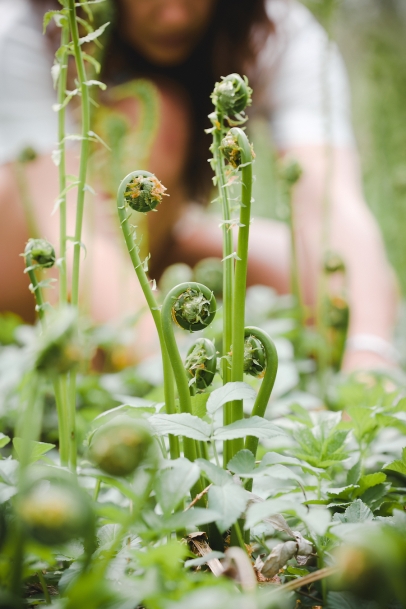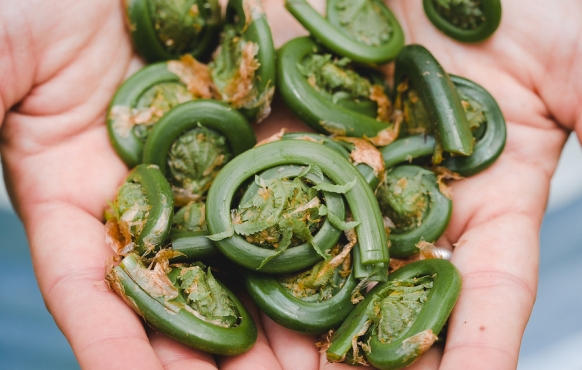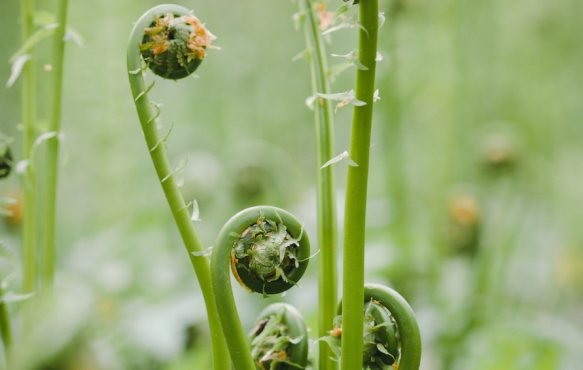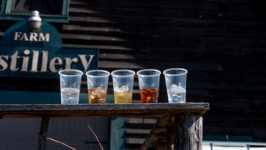Ostrich Fern Fiddleheads: The Fabulous Fronds of Spring

Fiddlehead, the name in itself is intriguing. It is defined as the furled frond of a young fern, usually of the ostrich species, that is harvested for use as a vegetable. This fern’s furled frond is harvested in late April, May and early June. The unusual name stems from the fact that the coiled frond has a similarity in shape to the curled scroll of a violin, hence the name fiddlehead. They are also known as “crosiers” or “croziers,” after the crookshaped staff of a bishop.
In North America, the Native Americans were the first to discover and eat these dainty delicacies. Fiddleheads have been part of the diet in northern France since the beginning of the Middle Ages and are also very popular in Asia. They may be found from Newfoundland to Alaska, British Columbia south to northern California, and in the Midwest and southern Appalachians. The plant is abundant in the upper Great Lakes and the Northeast as well as southern Canada.
These ferns are not cultivated but rather grow wild in wet areas such as the banks of brooks, streams, rivers and their floodplains. The most popular fiddlehead is the ostrich fern, which likes partial shade and flourishes under an umbrella of tree boughs. It is always wise to ask permission of the landowner before harvesting on someone else’s property.
The sought-after ostrich fern is a perennial, which grows in a clump called a “crown.” The part that is gathered and eaten is the young tender shoot called the “fiddlehead.” To identify this variety, look for a brown, papery, scale-like covering on the uncoiled fern. This papery covering is most easily removed when dry; shake gently and it will float away. There is a deep U-shaped groove on the inside of the ostrich fern’s smooth stem. Ostrich ferns are found in clusters of three to 12 fiddleheads each. They are best to harvest when two to six inches tall and have a one- to two-inch portion of the stem attached to the tightly curled fiddlehead. Harvest by snapping them off by hand or cutting with a knife.
Each plant usually produces seven tops that will turn into fronds. Remember to always harvest from crowns that have at least four fiddleheads, pass on those with only one or two. Pick only three tops per plant. Those that remain grow into fern fronds, which will make food for the next year. A plant will weaken, and eventually die, if all of the fiddleheads on its crown are picked year after year.
In the early 1990s, the Centers for Disease Control discovered a food-borne illness that was determined to be caused by eating raw or undercooked fiddleheads. It has since been proven that proper handling and cooking reduces this risk. Fiddleheads should NEVER be eaten raw. For safety standards, boil or steam them before using in most recipes. Cook for approximately 15 minutes when boiling, or 10 to 12 minutes if steaming. Using a steamer basket preserves the flavor. If you enjoy a mild taste that is similar to asparagus, boiling is best. For a more bitter flavor, like rapini, steaming should be the method of choice.
After boiling or steaming, ostrich fern fiddleheads can be used in most recipes that call for green vegetables. Stir-fries, soups and sautéing highlight this fiddlehead’s unique flavor. This vegetable is delicious when served with butter, lemon or in egg dishes with hollandaise sauce. It goes well with cheeses, tomato sauce and pasta dishes. For a tasty snack, marinate in vinegar and oil.
Nutritionally, fiddleheads have 34 calories per 100 grams and contain 72% of vitamin A’s and 44% of vitamin C’s daily requirement. Fiddleheads have no fat or cholesterol and are low in sodium and rich in potassium. If you prefer to buy rather than harvest your fiddleheads, they may be found at farmers’ markets or grocery stores that have a wild produce section. Their flavor is at its best right after harvesting, although they will keep for around 10 days if wrapped tightly and refrigerated. Because fiddleheads are only available for a few weeks in the spring, they are rather expensive. If they are pickled or frozen, some grocery stores may carry them year round. Ostrich fern fiddleheads, one more reason to look forward to spring.






